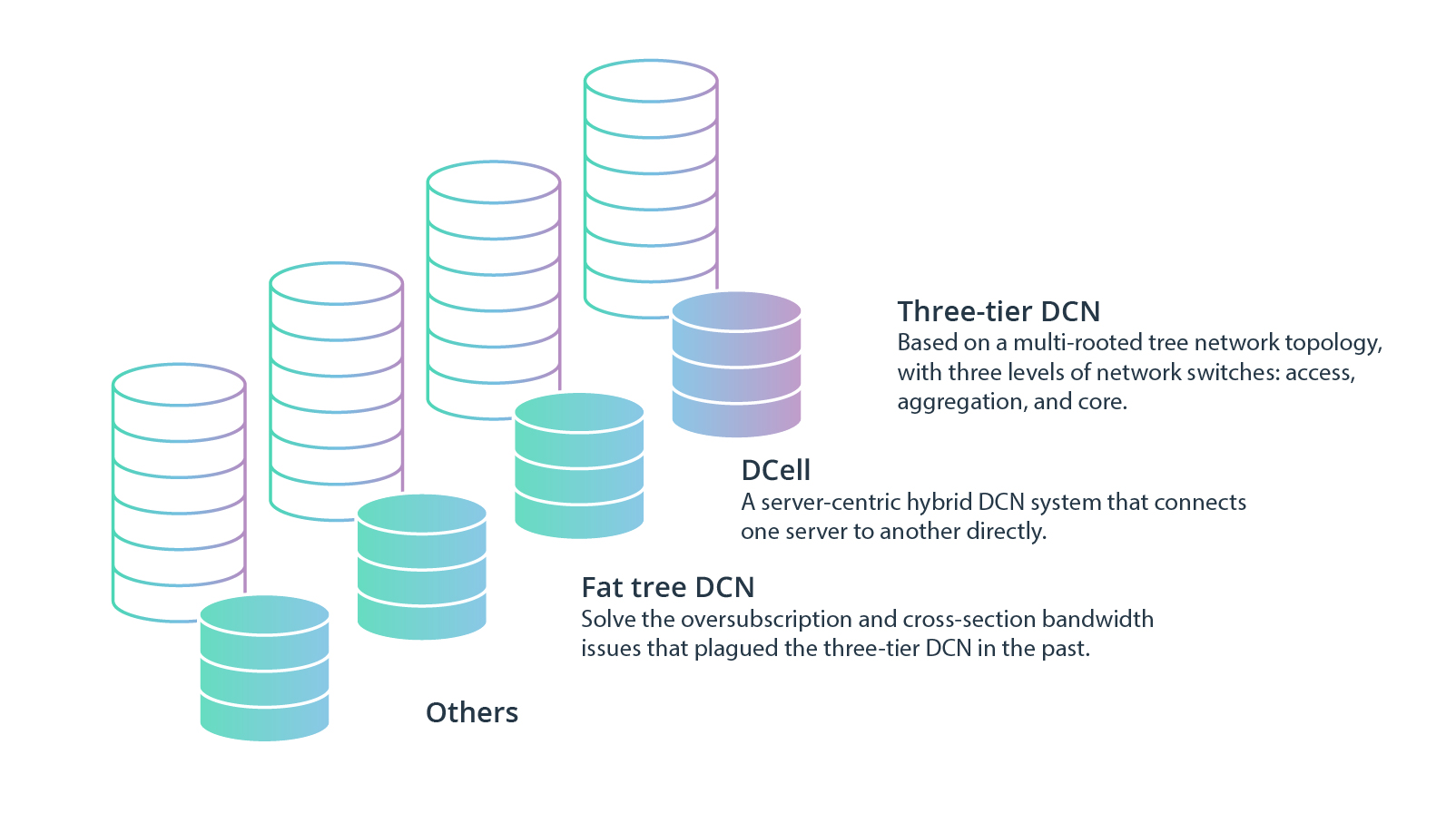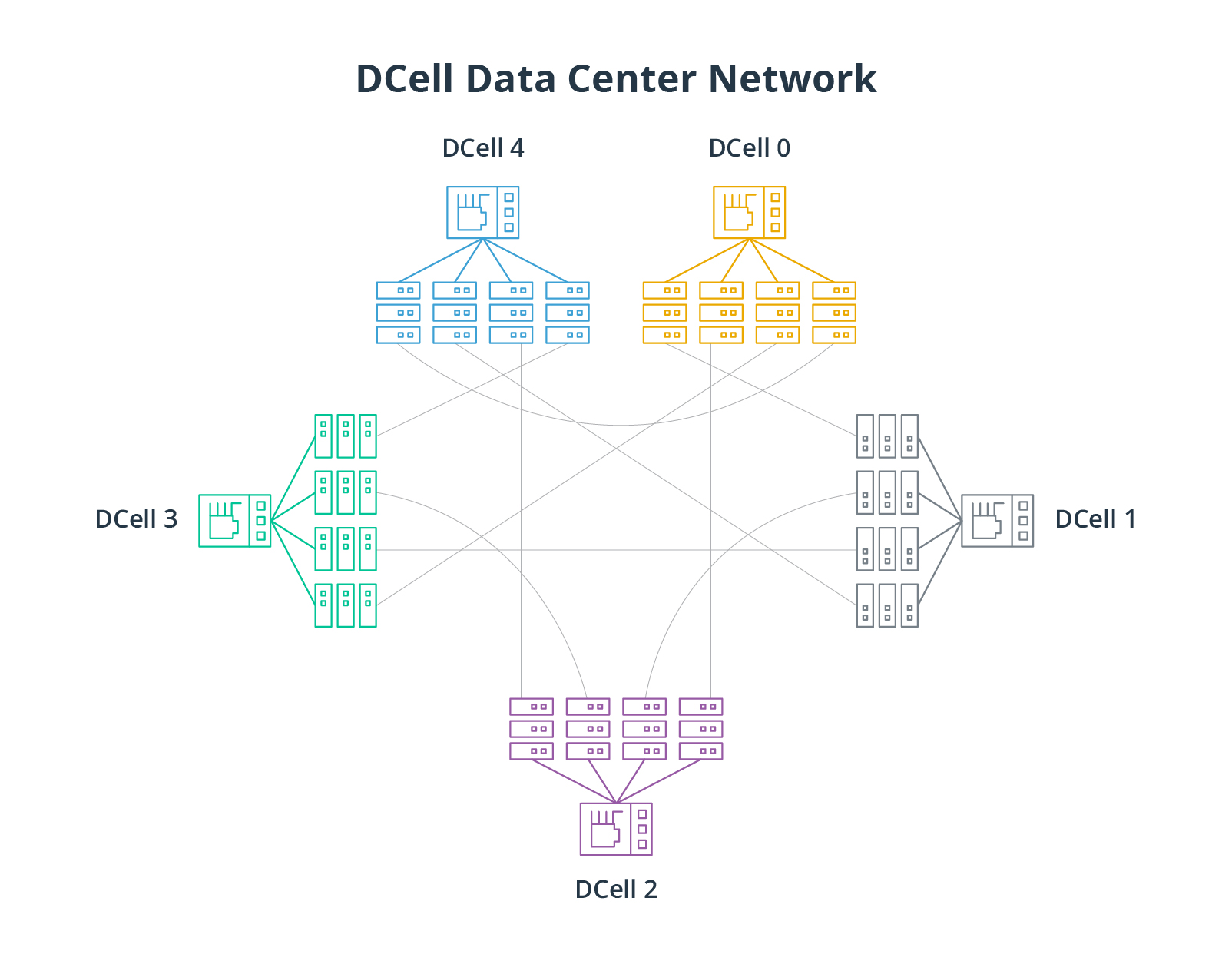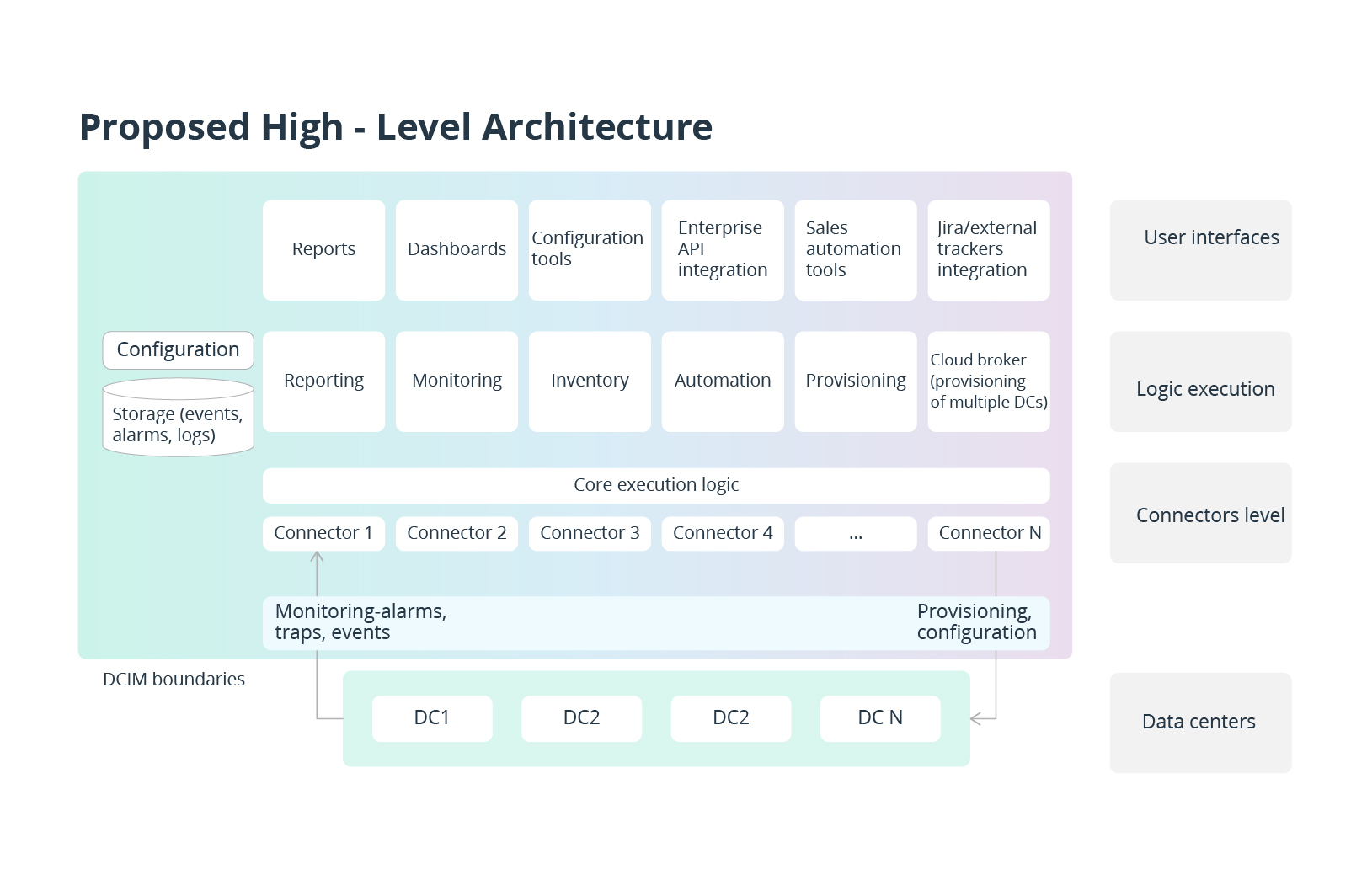Isn’t it fascinating how cloud services deliver essential data and applications anytime, anywhere?
Behind every cloud service is a data center: a physical facility that stores, processes, and distributes data and applications, centralizing an organization’s IT operations. Data centers ensure operational continuity by securely storing critical assets.
The design of a data center incorporates various physical and network devices such as firewalls, storage systems, routers, switches, and application delivery controllers. Data center networking solutions connect these devices and infrastructure nodes, facilitating seamless data transmission. Without these solutions, communication between data center devices and external networks would be impossible.
What is data center networking?
Data center networking (DCN) integrates various networking activities such as switching, routing, load balancing, and analytics to facilitate the storage, processing, and transmission of data and applications within a data center.
DCN connects data center infrastructure, including servers, storage systems, and networking devices, to ensure efficient and secure data transmission. By leveraging both physical components like routers and switches and modern virtualization technologies, data center networking supports applications and workloads across physical, cloud, and hybrid environments.
This integration enables centralized management, robust security, and seamless connectivity, ensuring that data flows smoothly within the data center and between the data center and external networks.
The importance of data center networking
Data center networking is essential for creating stable, reliable, scalable, and secure network infrastructure. It ensures that infrastructure meets an organization’s evolving communication needs while supporting cloud computing and virtualization. Additionally, enterprise data center networking solutions enhance operational consistency, automation, and security, which are crucial for efficiently delivering data and application services.
Data center networking is crucial because it:
- Centralizes resources and maintains operational consistency by simplifying the connection of resources across cloud, on-premises, and edge locations, ensuring consistent policies and unified management from a single console
- Automates network service provisioning by automating tasks, balancing workloads, and programming networks efficiently, enabling quick responses to changing needs
- Eases troubleshooting, providing a comprehensive view of the network and making it easier to identify and resolve issues quickly
- Improves data center security by protecting applications and data with integrated security controls like IDS, IPS, and microsegmentation, safeguarding against cyber threats
As you can see, data center networking is vital for maintaining a robust IT infrastructure. It supports the dynamic needs of modern organizations, facilitates efficient service delivery, simplifies troubleshooting, and enhances security, making it an indispensable component of any enterprise’s digital strategy.
How a data center network functions
Data center networking solutions are designed to meet the evolving demands of users and applications while automating tasks that were once manual and error-prone. They create secure digital connections between data center devices, ensuring a protected and efficient IT infrastructure.
One of the key functions of data center networking is to automate the provisioning of network services. This automation eliminates the errors and inefficiencies associated with manual processes, enabling faster and more reliable network service delivery. Additionally, these solutions handle the decommissioning of applications in line with de-provisioning policies, preventing outdated policies from compromising compliance, connectivity, and security.
Data center networking platforms also play a crucial role in managing network, server, and storage infrastructure. They ensure smooth data flows across on-premises devices, public clouds, and colocation centers using switches and routers. These tools monitor, diagnose, and fix issues with servers, storage, and network devices, ensuring that data services meet service-level agreements (SLAs).
By maintaining secure and efficient connections and automating critical tasks, data center networking solutions help organizations maintain a robust IT environment, support business operations, and meet their service delivery commitments.
Essential components of a data center network
- Servers are the backbone of every data center. These high-capacity computers, host applications and handle computing activities. They use a variety of storage systems including robotic tape drives, hard disk drives, and solid-state drives. To create high-bandwidth networks, servers rely on network interface controllers, cables, switches, and routers.
- Storage in a data center refers to the IT assets that store, back up, retrieve, and distribute applications and data. This includes network-attached storage (NAS), storage area networks (SAN), redundant array of independent disk (RAID) devices, direct-attached storage (DAS) devices, and backup management systems. While general IT storage encompasses both on-site and off-site assets, data center storage is exclusively on-site.
- Networks connect users and applications within the data center. A traditional three-tier network structure comprises an access layer for servers, a core layer at the edge connecting to the internet, and an aggregation layer linking the core to the access layer. This setup suits north–south data traffic (from outside to inside the data center, or vice versa) but can introduce latency in intra-data center traffic. Modern on-premises data center networks enhance mobility and scalability through hyperscale network security and software-defined networking (SDN).
- Power infrastructure includes equipment like busways, rack power distribution units (PDUs), floor PDUs, remote power panels, and uninterruptible power supply (UPS) devices, all of which power IT assets.
- Cooling infrastructure involves devices such as computer room air handlers (CRAH) and computer room air conditioning (CRAC) units, which maintain optimal temperatures for IT equipment.
- Cabling infrastructure comprises the cabling and associated hardware that facilitate data transmission among data center devices.
- Physical security devices protect data center assets with alarms, biometric scanners, and door locks, ensuring the security of a facility and its contents.
Comparing networks: campus, data center, and operations
Understanding the differences between campus networks, data center networks, and network operations centers (NOCs) is crucial for comprehending the unique role and significance of data center networking in modern IT infrastructure.
Each type of network serves distinct purposes, but data center networking stands out for its critical function in processing and managing business-critical data and applications.

Source: G2
A campus network, or campus area network (CAN), connects multiple local area networks (LANs) within a specific geographic area, such as a university, warehouse, or corporate office. This setup facilitates easy file sharing, internet access, and data transmission, offering users low latency and high availability since data remains within the network. Campus networks also provide efficient control over network resources.
In contrast, a data center network interconnects servers, firewalls, and other physical and virtual devices to enable ultra-low-latency data exchange. Unlike campus networks, data center networks implement a lossless queuing policy to prevent device crashes, ensuring smooth and reliable data processing that is crucial for business operations.
A network operations center (NOC), or network management center, is a centralized hub where an IT team monitors network health and performance to prevent disruptions or failures. The NOC continuously oversees infrastructure, firewalls, wireless systems, and network devices, swiftly addressing any emerging issues to maintain optimal network functionality.
Exploring different data center network architectures

Source: CommunityFS
Data center networks connect servers, nodes, and other devices using physical and wireless connections. The data center network design and architecture are vital for performance and scalability.
Let’s have a look at three main types of data center network architectures — three-tier, fat tree, and DCell — to understand how each one operates.
Three-tier data center network
The three-tier architecture is the most common in data centers. It consists of three layers: core, aggregation, and access. The core layer is responsible for advanced routing and connects the data center to the internet. The aggregation layer handles uplinks from the access layer, as well as firewalls and load balancing. The access layer, at the bottom, uses traditional top-of-rack (TOR) switches to connect client nodes to the network.

Source: G2
In this setup, a data packet first reaches the core layer, gets routed through the distribution layer, and finally arrives at the access layer, where it connects to the servers. This process involves multiple hops, leading to increased latency, especially with server-to-server traffic. While three-tier networks are effective for north–south traffic (from the user to the data center and back), they struggle with east–west traffic (server-to-server) due to potential packet drops and buffer overruns.
One key feature of three-tier networks is the spanning-tree protocol (STP), which prevents data loops. However, STP failures can lead to continuous looping. Despite their widespread use, three-tier networks face challenges with fault tolerance, scalability, bandwidth, and energy efficiency, particularly as cloud computing demands grow.
Fat tree data center network
Fat tree networks address some of the scalability and bandwidth issues of the three-tier design. Using a Clos topology, a fat tree network features a multistage switching architecture that minimizes port requirements and enhances non-blocking performance.

Source: G2
The distinguishing feature of fat tree networks is the equal number of links between switches at different levels. This architecture consists of k pods, each containing servers and switches at both access and aggregate layers. Each pod also includes core switches that link to the aggregate layer. The number of pods equals the number of ports per switch, which can limit scalability.
While fat tree networks improve cross-section bandwidth and reduce oversubscription issues, their tree-based structure can still struggle with extremely high-bandwidth activities and complex algorithms like MapReduce, which divide large data sets into manageable chunks for processing.
DCell data center network
The DCell architecture, developed in 2008, offers a server-centric, fault-tolerant, and scalable solution to the limitations of traditional tree-based structures. In a DCell network, servers are interconnected using mini switches in a recursive structure, eliminating single network bottlenecks and reducing the need for expensive routers or core switches.

Source: G2
The basic building block of a DCell network is the DCell 0, which includes several servers connected to a commodity network switch. Higher-level DCell structures (DCell 1, DCell 2, etc.) connect these blocks, creating a highly scalable design. For instance, a four-level DCell with six servers per DCell 0 can support up to 3.26 million servers.
DCell networks use a directional flow routing (DFR) algorithm to distribute traffic evenly, minimizing single points of failure and enhancing overall network resilience.
Three-tier, fat tree, and DCell architectures each have their strengths and weaknesses, and understanding their differences helps businesses choose the right network design to meet specific data center needs.
Efficient data center network management
Efficient data center network management relies on robust data center infrastructure management (DCIM) software. DCIM provides comprehensive guidelines for managing data center devices and their associated infrastructure, offering 360-degree visibility into the network’s configuration, components, and dependencies.
To ensure effective DCN management, focus on the following key areas:
Real-time availability
Monitoring real-time availability is crucial for understanding how well a data center can respond to performance and connectivity demands. High availability means your network can operate continuously without interruption. Using network monitoring tools allows for the early identification and resolution of potential issues, preventing outages and ensuring consistent performance.
Bandwidth monitoring
Effective bandwidth monitoring involves analyzing application growth and usage patterns to efficiently manage bandwidth consumption. By examining performance metrics such as discards, packet loss, traffic speed, and errors, you can plan for capacity needs and avoid traffic congestion. This proactive approach ensures superior network performance and smooth data flows.
Network configuration management
Proper network configuration management is essential to prevent misconfigurations that can lead to outages or revenue loss. DCN software with configuration and device lifecycle management capabilities simplifies the process of configuring devices, creating backups, and meeting compliance requirements. This ensures that all network assets are correctly set up and maintained, reducing the risk of disruptions.
Effective data center network management relies on comprehensive monitoring and management practices facilitated by DCIM software. By focusing on real-time availability, bandwidth monitoring, and network configuration management, you can maintain a high-performing, reliable, and secure data center network.
Visualizing data center networks
Visualizing a data center network is crucial for identifying and resolving performance issues, managing capacity, and troubleshooting effectively. Here are some common visualization methods that can help you quickly pinpoint and address problems within your data center network:
- Business views provide insights into the health and availability of network devices, storage systems, and servers by displaying their interface status. This high-level perspective helps you monitor overall network performance and detect any potential issues.
- Map views offer a geographical representation of database clusters, servers, networking devices, and storage devices. By visualizing the physical locations of these components, you can easily identify and address any regional issues affecting the network.
- 3D layouts of server rooms, racks, and ports provide a comprehensive view of your entire network operations center (NOC). These visualizations help you understand the physical arrangements and connections within your data center, making it easier to manage and optimize space and equipment.
- Layer 2 maps illustrate the entire data center network topology, showing connections between core routers, nodes, interconnected layers, and port-to-port connectivity of network devices. This detailed view helps you understand the structure and interconnections of your network, facilitating efficient troubleshooting and capacity planning.
- Closed-circuit television (CCTV) views enhance network monitoring by projecting network status and performance dashboards onto larger screens. This real-time visual representation allows for continuous oversight and a quick response to any emerging issues.
By employing these visualization methods, you can maintain a clear and detailed understanding of your data center network, enabling you to promptly address performance issues and ensure smooth operations.
Advantages of robust data center networking
Data center networking solutions offer numerous advantages, enhancing scalability and accelerating service delivery. With capabilities like root-cause identification and integrated analytics, these solutions effectively connect security, routing, and switching devices.
Here are some key benefits:
Operational simplicity
Managing disparate network architectures with various hardware switching tools, operating systems, and licensing plans can be complex and cumbersome. Data center networking simplifies IT operations by using a microservice architecture that ensures uniform operation for all switches across the entire enterprise network. This standardization reduces complexity and streamlines management.
Faster service delivery
Traditional data centers often rely on siloed infrastructure layers, requiring IT teams to spend significant time manually executing infrastructure requests and tasks. Data center networking tools enhance efficiency by enabling quicker IT operations and automated service provisioning across multiple network environments. This leads to faster delivery of services and improved responsiveness to business needs.
Easy troubleshooting
Data center networking tools make it easier to identify and resolve issues across both physical and virtual networks. This streamlined troubleshooting capability ensures quicker problem diagnosis and resolution, minimizing downtime and maintaining optimal network performance.
Common challenges of data center networking solutions
While data center networking offers numerous benefits, it also presents several challenges that organizations must address to maintain efficient and secure operations.
Here are some of them:
High energy requirements
Data centers consume significant amounts of energy to power and cool their infrastructure. Managing these energy requirements efficiently is crucial to control operational costs and environmental impact.
Lack of uninterruptible power supplies
Ensuring continuous power is essential for data center operations. Lack of an uninterruptible power supply (UPS) can lead to downtime and data loss during power outages, jeopardizing business continuity.
Insufficient physical space for expansion
As IT infrastructure needs grow, data centers often struggle with limited physical space for expansion. This constraint can hinder the addition of new servers, storage, and networking equipment, affecting scalability.
Unruly cables
Managing the multitude of cables connecting servers, networking equipment, and storage devices can be challenging. Disorganized cabling can lead to difficulties in troubleshooting, maintenance, and airflow management, potentially causing overheating and equipment failure.
Security issues
Data center network security is crucial in protecting against threats like cloud misconfigurations, phishing attacks, vulnerabilities in third-party solutions, and compromised credentials. Without robust security measures, these issues can result in data breaches, unauthorized access, and significant financial and reputational damage.
Addressing these challenges requires strategic planning, investment in reliable infrastructure, and robust security measures to ensure the smooth and secure operation of data center networks.
Our experience with data center networking services
Intellias has a proven track record of transforming data center operations for our clients. One notable success is our work on data center infrastructure for a leading telecommunications provider in the Middle East who sought our expertise to transition from a manual co-location model to an Infrastructure as a Service (IaaS) model.
We developed a comprehensive data center infrastructure management (DCIM) system that integrated the client’s existing Schneider Electric and Huawei data centers with public cloud resources. This ensured compliance with local data storage regulations while offering flexible billing and service options.
Our tailored DCIM software provided real-time monitoring, proactive capacity planning, and seamless integration with existing systems. It streamlined change management by automating tasks and tracking changes, significantly reducing the risk of errors. Effective asset management was a core feature, enabling the client to track and manage physical assets such as servers, networking equipment, and storage devices.

The impact was substantial. The client successfully transitioned to an IaaS model, achieving enhanced infrastructure visibility, reduced downtime, and optimized resource use. The powerful analytics enabled data-driven capacity planning, resulting in cost savings and improved efficiency. This collaboration highlights how tailored Intellias solutions drive operational excellence and competitiveness in the dynamic telecom market.
Intellias delivers cutting-edge data center networking solutions, empowering clients to achieve their operational goals and stay ahead in the industry.
Bottom line
A data center network serves as the central nervous system, connecting all data center infrastructure and devices. Its seamless information exchange is crucial for processing and delivering essential business data. Selecting the right networking solution ensures that your data center remains reliable, scalable, and flexible, enabling efficient and secure operations.



